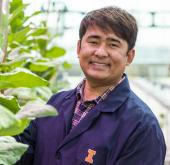Crops are cultivated at high density to achieve maximum yields on each acre. The plants grow together forming a dense canopy that does not allow light to penetrate to the lower leaves while the upper canopy leaves receive more light than they are able to use for photosynthesis. Computer simulations suggest that making the upper canopy leaves lighter and more erect while making the lower leaves darker and more horizontal would allow higher levels of photosynthesis to throughout the plant, greatly increasing photosynthetic efficiency and therefore yield. These simulations also suggest that many crops produce too many leaves for optimum light and nitrogen use efficiency. RIPE is working to develop crops with more optimized canopies.

Prominent global change scientist joins crop sciences, plant biology at Illinois
Globally recognized as one of the most influential modern scientists, RIPE Deputy Director Lisa Ainsworth has been named Professor and C.A. Ewing Chair of Crop Physiology in the Department of Crop Sciences and the Department of Plant Biology at the University of Illinois Urbana-Champaign.
For two decades, Ainsworth has helped shape climate change research at SoyFACE
Lisa Ainsworth, the head of the USDA ARS Global Change & Photosynthesis Unit at SoyFACE, has left an indelible mark on the advancement of crop resilience to climate change.

OVER THE COLES: Dynamic photosynthesis model simulates 10-20 percent yield increase
A team from the University of Illinois has developed a model that treats photosynthesis as a dynamic process rather than an activity that either is or is not happening.
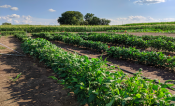
Scientists further cowpea research—boosting canopy CO2 assimilation, water-use efficiency
RIPE has analyzed how much variation exists within cowpea lines in light absorption and CO2 assimilation throughout the canopy.
Light green plants save nitrogen without sacrificing photosynthetic efficiency
RIPE scientists designed plants with light green leaves to allow more light to penetrate the crop canopy to increase light-use efficiency and yield.

Soybean plants with fewer leaves yield more
Using computer model simulations, scientists predicted fewer leaves could boost yields and confirmed it works in real-world field trials—increasing soybean production by 8%. This yield gain, which far surpasses the one percent average, is needed to produce 70-100% more food by 2050 to feed an estimated 9.7 billion people.







